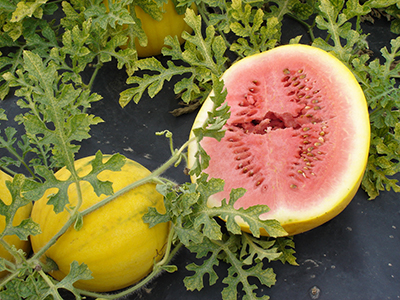Citrullus lanatus (Thumb.) Matsum. et Nakai (Cucurbitaceae) cv. Zloto Wolicy F1



-->
| ENG | Watermelon |
| SK | Dyna cervena |
| CZ | Vodni meloun |
| PL | Arbuz zwyczajny |
| HU |
Using
Water melon is commonly cultivated for fruit which has a sweet, pulpy flesh. Fruit is comprised mainly of water (often over 90%), but it also contains important nutritional compounds, including sugars, minerals, lycopene, and amino acids. The rind contains i.a. alkaloids, saponins, and flavonoids. The seed oil is composed i.a. with glycosides of linoleic, oleic, palmitic, and stearic acids. These compounds are a biochemical background of traditional use of watermelon rind as purgative, emetic, vermifuge, demulcent, diuretic, and tonic. The seeds are used in the treatment of urinary tract infections, dropsy and renal stones, hypertension, diabetic, diarrhea, and gonorrhoea.
| I. | II. | III. | IV. | V. | VI. | VII. | VIII. | IX. | X. | XI. | XII. | |||||||||||||
| Sowing | ||||||||||||||||||||||||
| Planting | ||||||||||||||||||||||||
| Harvest | ||||||||||||||||||||||||
Botanical description and occurrence:
Watermelon is native to Southern Africa where it had been cultivated in for over 4,000 years. Plant is annual, prostrate or climbing, with several herbaceous stems up to 3 m long. The young parts are covered by hairs. The leaves are usually deeply 3-lobed with the segments also lobed. The plant is monoecious, flowers are yellow. The fruit is usually globose to oblong or ellipsoid, sometimes ovoid, 5–70 cm long. The seeds are obovate, smooth, yellow to brown or black.
‘Zloto Wolicy‘ F1 is an early hybrid, little susceptible to powdery mildew. It has spherical to elongated fruit, with pink flesh, yellow rind and light brown seeds.
Why to have the plant in your garden:
The watermelon ‘Zloto Wolicy‘ F1 is decorative during whole vegetation period. Long, creeping stems have leaves with yellow discoloration. Fruit’s rind, first green, when ripe turns yellow. The flesh is red, firm, juicy and very sweet.
Text:
Dr. Agnieszka Sekara, University of Agriculture in Krakow, Poland
Photo:
Dr. Agnieszka Sekara, University of Agriculture in Krakow, Poland

